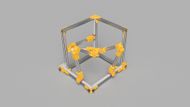Tripteron
|
English • العربية • български • català • čeština • Deutsch • Ελληνικά • español • فارسی • français • hrvatski • magyar • italiano • română • 日本語 • 한국어 • lietuvių • Nederlands • norsk • polski • português • русский • Türkçe • українська • 中文(中国大陆) • 中文(台灣) • עברית • azərbaycanca • |
Release status: working
Overview
This is a 3D printer designed by Apsu as a prototype implementation of the Tripteron motion platform, details of which can be found here. This system is both linear and Cartesian in actuation, featuring a fixed build platform, parallel kinematics, and simple construction and operation. The design is still a work-in-progress, and is ongoing primarily in this forum thread.
You can see video of a prototype running here, and a livestream Q&A with the designer here.
The printer was also featured on Hackaday and has garnered a lot of interest as a potential new way forward in printer development.
Benefits
- Linear actuation provides constant precision throughout the build volume
- In this orthogonal configuration, the kinematics are simple Cartesian
- A fixed build platform is simple and allows for consistency and high performance
- Parallel actuation avoids compounding of mechanical errors, if any exist
- Framing and assembly are easy
- Part count is low
- The mechanism being simple and reconfigurable into different orientations allows for a lot of hackability and room for creative improvements
Challenges
- Designing and constructing a rigid arm assembly is difficult and demanding engineering, particularly with only common RepRap materials and printed parts
- Understanding the mechanism is non-intuitive and devising appropriate joints takes some creative thinking
- The arm assembly weight falls mostly on the Z axis arm, so proper reinforcement and load management takes some engineering work
